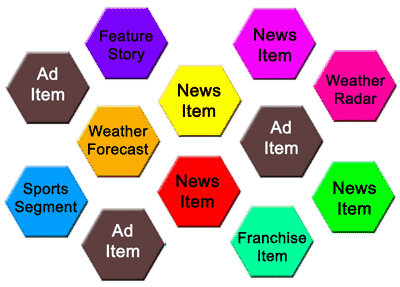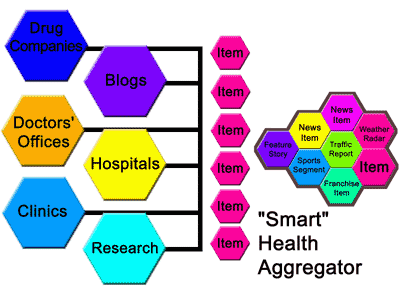 |
→ December 2005 Contents → Column
|
TV News in a Postmodern World
The Remarkable Opportunities of Unbundled Media |
 |
|
What parent isn't familiar with the struggle to get little Johnny to eat those food items that taste a little different? These sorts of food wars have changed over the years, because our addiction to fast food has produced mouths and taste buds that have difficulty trusting anything that doesn't come in a wrapper. It's not just Brussels sprouts anymore. My then 13-year old daughter once spit out a mouthful of homemade strawberry pie (imagine that), because the texture was unfamiliar and somehow threatening. But we grow up, and we try things. We discover that our fears were silly. This analogy is apropos to many things in life, and especially in the media world today. Unbundled media, for example, is an acquired taste, but once the palette has been sufficiently soaked in its broth, there is no going back. This is the great and deadly reality confronting all of the mainstream, for bundled media is all we know, and it's increasingly a Twinkie next to the strawberry pie of that which is unbundled. Television newscasts and programs, CDs, the morning paper, cable TV tiers, magazines, books, movies — virtually every form of mass media comes already bundled. It's as much a part of our consumer society as keeping up with the Joneses. The bundle includes everything that makes up the whole, from the content to the ads. This is how we do things. "Drive people to the bundle" is the mantra of mass marketing, which then uses its part of the bundle to rifle unwanted messages this way and that. But bundled media has a serious drawback, one that cannot be wished away. It takes time to consume anything prebundled, and time is a precious and valued commodity in today's world. We're working more, and we have less time to ourselves. And so, driven by the very real demand of less time, we've begun the process of tasting that which is unbundled. We unbundle television shows by skipping the commercials with our DVRs. We unbundle CDs by downloading the songs we want. We unbundle the national media by subscribing to specific RSS feeds. The signs of a burgeoning unbundled media world are everywhere. Viacom's Comedy Central cable channel is launching what they're calling a "broadband TV channel." Motherload will essentially be a Website offering unbundled TV media. Modeled after MTV's Overdrive (also Viacom), the site offers ad-supported two to eight minute clips in a slick Flash player. It'll be original content, along with some repurposed Comedy Central clips. The possibilities for this concept are endless, and Viacom is smart to be exploring here. MSNBC is beginning to offer a same-day stream of NBC Nightly News. The video stream will be available at 10pm ET each night after the last station on the West Coast has aired it. ABC has inked a deal with Apple to provide same day, downloadable feeds of some of its programming, which can be played in the new Video iPod. All of these are forms of unbundled media, and this is just the beginning. Unbundling will take place at the most basic levels, and technologies will flourish that assist people in rebundling according to their preferences. Our response as media professionals has been to sigh and offer repurposed media items to the noisy crowd that used to be our consumers. This is a grave mistake, for it shortsightedly views the drift to unbundled media as a sideshow. It is not; it's the whole enchilada, and while we're busy toying with it, people we never imagined would be our competitors are grabbing market share. Can you say "Yahoo!?" The problem is that while we're repurposing our content, the bulk of our attention is still focused on the creation of that which is bundled. That's where the money is, we convince ourselves, and so we don't ask the right questions. Like what could we do differently in a world of unbundled media? As TV news people, for example, would we start our day thinking about how we're going to fill the hole of the evening newscast, and empower program producers to use our considerable resources to craft bundled programs? Or would we think about creating unbundled bits that could be repurposed in a bundled program and along the way be made available in their unbundled form?  Perhaps it's time for those of us in local mainstream media to start thinking seriously about this unbundled thing. In so doing, we might actually discover that elusive business model that everybody's waiting for. The business model is not as far away as you might think. There are at least six ways we can make money in an unbundled media world, and only a couple of them are obvious. For purposes of discussion, an "item" is any unbundled piece of media, including advertisements, provided by the media company.
The business opportunities for unbundled media are truly remarkable, but in order for local media companies to take advantage of them, they must begin viewing themselves as more than one-dimensional deliverers of bundled media. For broadcasters, that means finding the courage to say to ourselves that our transmitter isn't our top business anymore. It's but one of many, and our internal systems and even our organizational charts should reflect that. Only then will we be able to truly reinvent ourselves for the future. This is a tough sell for the industry, because our bread and butter, bundled models are still delivering significant revenues and will continue to do so for years to come. Those revenues, however, won't (can't) be enough to sustain real business growth, and so the only choice seems to be to cut costs. We keep missing the point that revenue isn't the problem; audience is the problem, and they're moving to the unbundled world. And they're not coming back, either. After all, once you've acquired a taste for filet, a steady diet of hamburger doesn't cut it anymore.
© Terry Heaton
|
|
Back to December 2005 Contents
|
|



